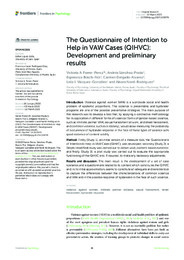Please use this identifier to cite or link to this item:
https://hdl.handle.net/11000/31316Full metadata record
| DC Field | Value | Language |
|---|---|---|
| dc.contributor.author | Ferrer-Perez, Victoria A. | - |
| dc.contributor.author | Sánchez-Prada, Andrés | - |
| dc.contributor.author | Bosch-Fiol, Esperanza | - |
| dc.contributor.author | Delgado-Alvarez, Carmen | - |
| dc.contributor.author | Vázquez González, Leila Irea | - |
| dc.contributor.author | Nardi-Rodríguez, Ainara | - |
| dc.contributor.other | Departamentos de la UMH::Ciencias del Comportamiento y salud | es_ES |
| dc.date.accessioned | 2024-02-08T13:11:41Z | - |
| dc.date.available | 2024-02-08T13:11:41Z | - |
| dc.date.created | 2023-03 | - |
| dc.identifier.citation | Frontiers in Psychology Volume 14 - 2023 | es_ES |
| dc.identifier.issn | 1664-1078 | - |
| dc.identifier.uri | https://hdl.handle.net/11000/31316 | - |
| dc.description.abstract | Introduction: Violence against women (VAW) is a worldwide social and health problem of epidemic proportions. This violence is preventable, and bystander programs are one of the possible preventative strategies. The main purpose of this research was to develop a tool that, by applying a contrastive methodology for its application in different forms of violence (forms of gender-based violence, such as intimate partner VAW, sexual harassment at work, and street harassment, and common violence, such as a robbery), would allow measuring the probability of occurrence of bystander response in the face of these types of violence with good evidence of content validity. Method: Firstly (Study 1), an initial version of a measure tool, the Questionnaire of Intention to Help in VAW Cases (QIHVC), was developed; secondly (Study 2), a Delphi (modified) study was carried out to obtain valid, content-based evidence; and finally (Study 3), a pilot study was carried out to evaluate the appropriate functioning of the QIHVC and, if required, to make any necessary adjustments. Results and discussion: The main result is the development of a set of case scenarios and a questionnaire related to its content which constitutes the QIHVC and, in its initial approximation, seems to constitute an adequate and sensible tool to capture the differences between the characterizations of common violence and VAW and in the possible response of bystanders in the face of such violence | es_ES |
| dc.format | application/pdf | es_ES |
| dc.format.extent | 19 | es_ES |
| dc.language.iso | eng | es_ES |
| dc.publisher | Frontiers Media | es_ES |
| dc.rights | info:eu-repo/semantics/openAccess | es_ES |
| dc.rights | Attribution-NonCommercial-NoDerivatives 4.0 Internacional | * |
| dc.rights.uri | http://creativecommons.org/licenses/by-nc-nd/4.0/ | * |
| dc.subject | violence against women | es_ES |
| dc.subject | intimate partner violence | es_ES |
| dc.subject | sexual harassment | es_ES |
| dc.subject | street harassment | es_ES |
| dc.subject | bystander response | es_ES |
| dc.subject.other | CDU::6 - Ciencias aplicadas::61 - Medicina::613 - Higiene en general. Higiene y salud personal | es_ES |
| dc.title | The Questionnaire of Intention to Help in VAW Cases (QIHVC): Development and preliminary results | es_ES |
| dc.type | info:eu-repo/semantics/article | es_ES |
| dc.relation.publisherversion | https://doi.org/10.3389/fpsyg.2023.1153678 | es_ES |

View/Open:
2-OA- PUBLISHED MANUSCRIPTfpsyg- (1).pdf
1,51 MB
Adobe PDF
Share:
.png)
